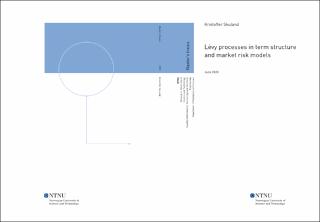| dc.contributor.advisor | Laading, Jacob Kooter | |
| dc.contributor.author | Skuland, Kristoffer | |
| dc.date.accessioned | 2021-09-15T17:25:48Z | |
| dc.date.available | 2021-09-15T17:25:48Z | |
| dc.date.issued | 2020 | |
| dc.identifier | no.ntnu:inspera:55607230:38101433 | |
| dc.identifier.uri | https://hdl.handle.net/11250/2778335 | |
| dc.description.abstract | Vi modellerer rentemarkeder med Lévy-terminstrukturmodeller generert av normal–inverse gaussiske (NIG) fordelinger og generaliserte hyperboliske skjeve Students (GSS) t-fordelinger. Vi sammenlikner modellene med en klassisk gaussisk Heath–Jarrow–Morton-modell i backtester av endags value-at-risk og expected shortfall på rentederivater. NIG- og GSS-modellene gir de beste tilnærmingene av de undersøkte risikomålene, og vi konkluderer med at vi ikke kan vurdere markedsrisikoen til rentederivater nøyaktig uten å ta hensyn til diskontinuerlige hopp, halvtunge haler og potensiell skjevhet i avkastningsfordelingene. GSS-modellene gir den beste beskrivelsen av endags expected shortfall. Under finanskrisene fra 2008 til 2009 og våren 2020 undervurderer de gaussiske modellene konsekvent halerisikoen. Under den nylige krisen fra februar til april 2020 er den ekstremt skjeve og haletunge markedsatferden uforenlig med en gaussisk genererende fordeling, mens NIG- og GSS-modellene, selv om de er for konservative i den nedre halen av avkastningsfordelingen, gir en rimelig tilnærming av risikoen tilsvarende fallende renter. | |
| dc.description.abstract | We model fixed-income markets with Lévy term structure models generated by normal–inverse Gaussian (NIG) distributions and generalised hyperbolic skew Student's (GSS) t-distributions. We compare the models against a classical Gaussian Heath–Jarrow–Morton model in out-of-sample backtests of one-day value-at-risk and expected shortfall on interest rate derivatives. The NIG and GSS models provide the best approximations of the studied risk measures, and we conclude that we cannot accurately assess the market risks of interest rate derivatives without taking into account jump dynamics, semi-heavy tails, and possible skewness in the return distributions. The GSS models admit the best overall description of one-day expected shortfall. During the financial crises from 2008 to 2009 and spring 2020, the Gaussian models consistently underestimate the tail risks. During the recent crisis from February to April 2020, the highly skewed and heavy-tailed market behaviour is incompatible with a Gaussian generating distribution, while the NIG and GSS models, though too conservative in the lower tail of the return distributions, provide reasonable approximations of the risks corresponding to falling interest rates. | |
| dc.language | | |
| dc.publisher | NTNU | |
| dc.title | Lévy processes in term structure and market risk models | |
| dc.type | Master thesis | |
